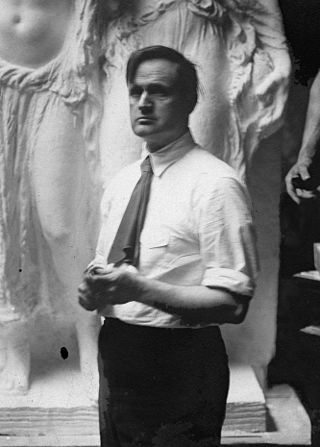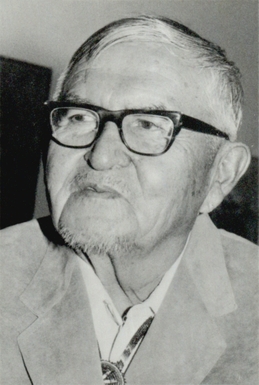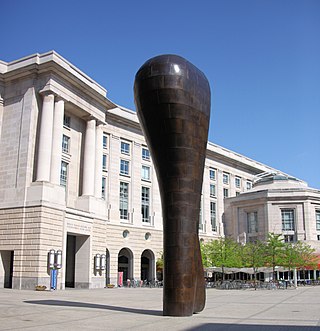
Gertrude Vanderbilt Whitney was an American sculptor, art patron and collector, and founder in 1931 of the Whitney Museum of American Art in New York City. She was a prominent social figure and hostess, who was born into the wealthy Vanderbilt family and married into the Whitney family.

Dupont Circle is a historic roundabout park and neighborhood of Washington, D.C., located in Northwest D.C. The Dupont Circle neighborhood is bounded approximately by 16th Street NW to the east, 22nd Street NW to the west, M Street NW to the south, and Florida Avenue NW to the north. Much of the neighborhood is listed on the National Register of Historic Places. However, the local government Advisory Neighborhood Commission and the Dupont Circle Historic District have slightly different boundaries.

James Earle Fraser was an American sculptor during the first half of the 20th century. His work is integral to many of Washington, D.C.'s most iconic structures.

Alexander Phimister Proctor was an American sculptor with the contemporary reputation as one of the nation's foremost animaliers.
The Albert Einstein Memorial is a monumental bronze statue by sculptor Robert Berks, depicting Albert Einstein seated with manuscript papers in hand. It is located in central Washington, D.C., United States, in a grove of trees at the southwest corner of the grounds of the National Academy of Sciences at 2101 Constitution Avenue N.W., near the Vietnam Veterans Memorial. Two replicas exist at the Israel Academy of Sciences and Humanities and the Georgia Institute of Technology.

The Dumbarton Bridge, also known as the Q Street Bridge and the Buffalo Bridge, is a historic masonry arch bridge in Washington, D.C.

Percy Bryant Baker better known as Bryant Baker, was a British-born American sculptor. He sculpted a number of busts of famous Americans. In 1910, Queen Alexandra of the United Kingdom commissioned him to create a bust of King Edward VII.

Allan Capron Houser or Haozous was a Chiricahua Apache sculptor, painter, and book illustrator born in Oklahoma. He was one of the most renowned Native American painters and Modernist sculptors of the 20th century.

William Henry Rinehart was a noted American sculptor. He is considered "the last important American sculptor to work in the classical style."

Albert Paley is an American modernist metal sculptor. Initially starting out as a jeweler, Paley has become one of the most distinguished and influential metalsmiths in the world. Within each of his works, three foundational elements stay true: the natural environment, the built environment, and the human presence. Paley is the first metal sculptor to have received the Lifetime Achievement Award from the American Institute of Architects. He lives and works in Rochester, New York with his wife, Frances.
Washington, D.C., is the capital city and federal district of the United States. Below is a list of Washington, D.C.-related articles.
Leo Villareal is an American artist. His work combines LED lights and encoded computer programming to create illuminated displays. He is living and working in New York City.

Brevet Lt. General Winfield Scott is an equestrian statue in Washington, D.C., that honors career military officer Winfield Scott. The monument stands in the center of Scott Circle, a traffic circle and small park at the convergence of 16th Street, Massachusetts Avenue and Rhode Island Avenue NW. The statue was sculpted by Henry Kirke Brown, whose best-known works include statues of George Washington in New York and Nathanael Greene in Washington, D.C. It was the first of many sculptures honoring Civil War generals that were installed in Washington, D.C.'s traffic circles and squares and was the second statue in the city to honor Scott.

The statue of John Aaron Rawlins, a United States Army general who served during the Civil War and later as Secretary of War, is a focal point of Rawlins Park, a small public park in Washington, D.C.'s Foggy Bottom neighborhood. It was installed in 1874, but relocated several times between 1880 and 1931. The statue was sculpted by French-American artist Joseph A. Bailly, whose best known work is the statue of George Washington in front of Independence Hall in Philadelphia.
Monumental Head is a 1960 bronze sculpture by Alberto Giacometti, installed at the Hirshhorn Museum and Sculpture Garden in Washington, D.C., in the United States. The abstract work measures 37 x 11 3/4 x 14 3/4 inches and depicts a roughly modeled head with an extended neck. Other casts of Monumental Head from this period are found in the collections of other institutions, including the Phillips Collection and the Los Angeles County Museum of Art.

Theodore Roosevelt, Rough Rider is a bronze sculpture by American artist Alexander Phimister Proctor, formerly located in the South Park Blocks of Portland, Oregon in the United States. The equestrian statue was completed in 1922 and depicts Theodore Roosevelt as the leader of the cavalry regiment that fought during the Spanish–American War called the Rough Riders. It was toppled by demonstrators during the Indigenous Peoples Day of Rage in October 2020 and has not been restored.
Martha Jackson Jarvis is an American artist known for her mixed-media installations that explore aspects of African, African American, and Native American spirituality, ecological concerns, and the role of women in preserving indigenous cultures. Her installations are composed using a variety of natural materials including terracotta, sand, copper, recycled stone, glass, wood and coal. Her sculptures and installations are often site-specific, designed to interact with their surroundings and create a sense of place. Her works often focus on the history and culture of African Americans in the southern United States. In her exhibition at the Corcoran, Jarvis featured over 100 big collard green leaves, numerous carp and a live Potomac catfish.

Bearing Witness is an outdoor 1997 sculpture by Martin Puryear, installed outside the Ronald Reagan Building and International Trade Center in Washington, D.C., in the United States. Twenty plus years after its construction the sculpture follows the characteristic style of Puryear and remains standing with minimal maintenance twenty plus years after its construction. The meaning of the sculpture is left up to interpretation, although many observers read into the inspirations Puryear may have had when designing the work.

Indian Maiden and Fawn is a 1917–1924 sculpture by Alexander Phimister Proctor.















